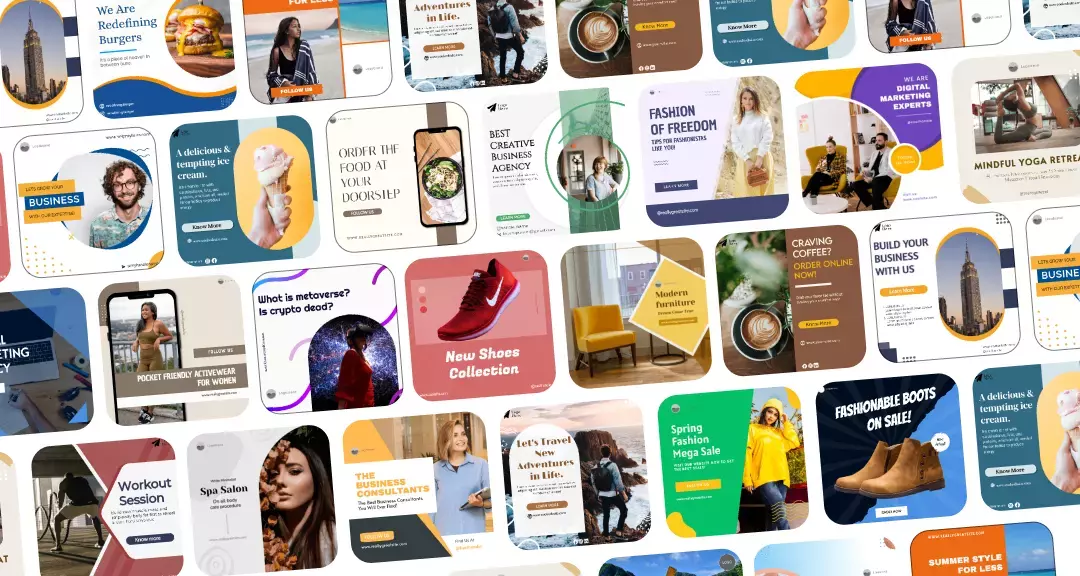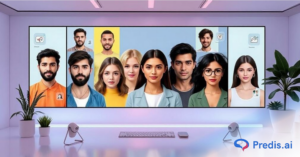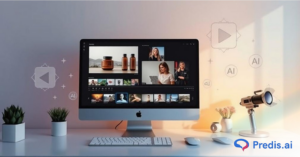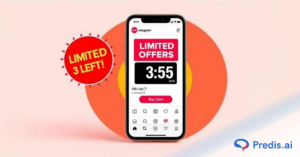Creating high-performing digital ads can feel overwhelming when you are juggling multiple formats, constant creative variation needs, and tight deadlines. Many marketers face creative fatigue simply because producing fresh visuals, videos, and copy for every platform takes too much time. This is where the top tools to create digital ad creatives make a real difference by cutting down the workload and speeding up the entire process.
With the right tool stack, you can create platform-ready ads faster, test more variations, and keep your campaigns performing without burning out your design or marketing team. In this guide, you will discover the most reliable tools that help you design, scale, and optimize digital ad creatives in a smarter and more streamlined way.

Why Creative Speed and Scale Matter
In today’s ad environment, winning campaigns are built on speed, consistency, and the ability to test multiple variations quickly. Brands that produce more creative variations tend to see better performance because they can identify what resonates faster. Meta’s internal studies show that advertisers who test multiple creatives see noticeably higher conversion rates compared to those who rely on a single asset. This makes creative volume a direct competitive advantage.
When you slow down production, you slow down learning. If it takes a full week to make a new visual or video, you miss opportunities to test new angles, hooks, and formats that could lift your ROI. Fast creative cycles help you stay aligned with trends, audience behavior, and platform changes. They also reduce the chances of creative fatigue, where old ads stop performing because your audience has already seen them too often.
Consistent branding is another crucial factor. When scaling creatives across platforms manually, tiny errors or mismatched formats can dilute brand identity. The right tools help you maintain visual consistency while still allowing rapid iteration. This balance of speed and quality ultimately improves time to market, boosts optimization speed, and keeps your cost per result in check.
What Makes a Great Ad-Creative Tool
A strong ad-creative tool isn’t just about generating visuals. It helps you move faster, stay consistent, and publish with confidence. When evaluating tools, these are the features that matter most:
- Ease of use: The interface should feel intuitive. If it takes hours to learn, it will slow down your creative cycle instead of speeding it up.
- Multiformat export: A good tool should let you create ads for Meta, TikTok, YouTube, Pinterest, and Google in the correct sizes. This matters because resizing manually can take longer than making the creative itself.
- High-quality templates: Templates help you produce polished ads quickly and reduce redesign time. They’re especially useful when you need multiple variations for A/B testing.
- Brand controls: Features like brand kits, color palettes, fonts, and reusable layouts ensure every creative stays on-brand. Consistency boosts recall and builds trust.
- AI generation features: Tools with AI can generate copy, layouts, image variations, and even video ads. This cuts down hours of manual work and allows faster experimentation.
- Integrations with ad platforms: When a tool connects with Meta, Google, Shopify, or scheduling tools, it simplifies publishing, tracking, and collaboration.
- Team collaboration features: Real-time commenting, shared libraries, and approval workflows prevent back-and-forth confusion and speed up production.
- Pricing flexibility: The best tools offer tiers for individuals, small teams, and agencies. You shouldn’t need enterprise-level spending to create high-quality ads.
These criteria help you choose tools that don’t just look impressive, but genuinely improve your creative output and reduce time to market.
Top Tools to Create Digital Ad Creatives
| Tool Name | Best For | Pricing Range | Pros | Cons | AI Capability |
|---|---|---|---|---|---|
| Predis.ai (Top Pick & Most Complete Tool) | Fast AI-powered static & video ad creatives, variations, and scheduling | Free plan available; paid plans from $19/mo | End-to-end workflow: creates images, videos, captions, variations, and lets you publish from one dashboard | Some advanced automation is available only in higher tiers | Advanced AI for copy, visual generation & UGC-style video ads |
| Canva Pro | Template-based social & display ad designs | Free; Pro from $12.99/mo | Large library of ad templates for major platforms | Limited automated variation generation | Basic AI text + simple visual tools |
| Figma | Collaborative design systems for ad teams | Free; paid $12–$45/editor/mo | Excellent for reusable components & brand consistency | Not built for fast ad or video generation | Minimal AI functionality |
| Kapwing | Quick video edits, trimming, captioning, resizing | Free; paid from $16/mo | Extremely fast for repurposing video content | Limited polished ad templates | Moderate AI support |
| VEED.io | Motion-graphic video ads | Free; paid $18–$59/mo | Great motion elements, transitions & effects | Less flexible than pro video editors for complex edits | Moderate AI generation features |
| Piktochart | Infographic-style ads for B2B, SaaS, data-driven campaigns | Free; paid $14–$29/mo | Ideal for data visuals & charts in ads | Not suited for ecommerce-style creatives | Minimal AI capabilities |
| VistaCreate | Quick display banners & simple animated ads | Free; paid ~$13/mo | Very beginner-friendly and template-rich | Limited automation and AI-driven design | Basic AI tools |
| Adobe Express | Premium-looking ads without Adobe Suite complexity | Free; paid $9.99/mo | High-quality templates & strong brand tools | Not optimized for quick creative variation/testing | Basic–moderate AI |
1. Predis.ai: Best for fast, AI-powered ad creatives and videos
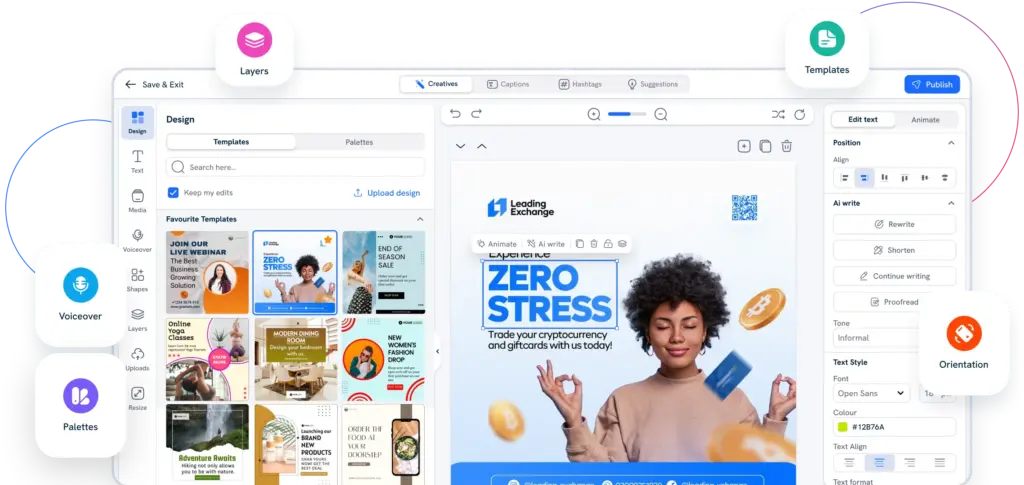
About the tool:
Predis.ai stands out because it covers the entire ad-creative workflow from start to finish. You can generate static ads, video ads, UGC-style videos, captions, and multiple variations from a single brief or product link. It also adapts creatives automatically to platform-specific sizes and supports scheduling and publishing — a combination most tools don’t offer.
This makes Predis.ai the strongest choice for creators, agencies, and ecommerce brands that want maximum speed, automation, and consistent output quality.
Pricing:
Trial plan available. Paid plans start at $19/month.
Pros:
- Generates ad images, videos, UGC clips, and captions from one brief
- Built-in resizing, variation generation, and auto-posting
- Extremely efficient for repurposing product URLs or assets
Cons:
- Some creatives may need light brand refinements
- Higher-tier automations available in premium plans
2. Canva Pro
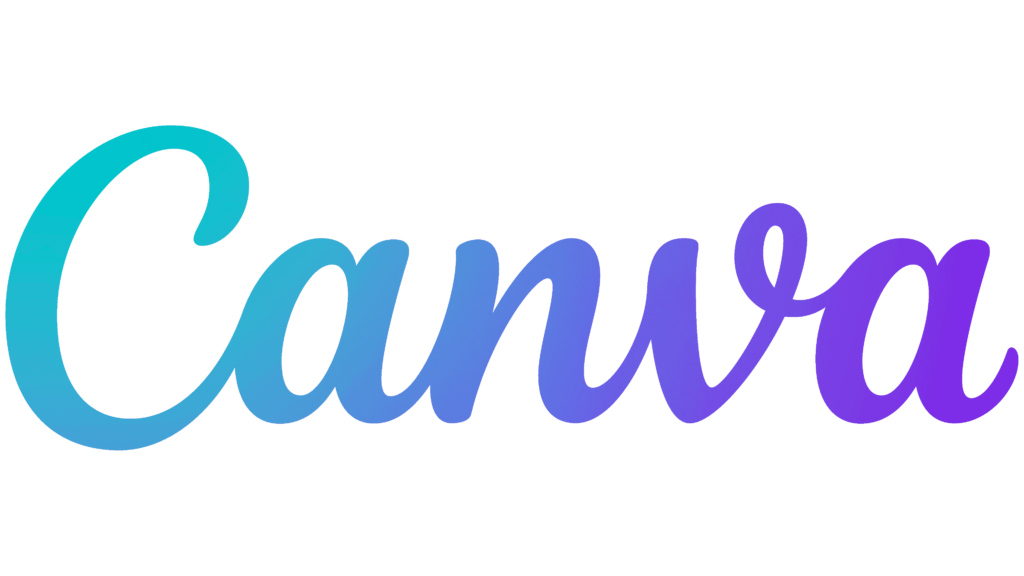
About the tool:
Canva Pro provides a wide library of templates for social ads, display banners, thumbnails, and promotional graphics. It is widely used for creating static visuals using drag-and-drop editing.
Pricing:
Free plan available. Pro plan starts at $12.99/month.
Pros:
- Large template collection
- Easy-to-use editor
- Collaboration and brand kit features
Cons:
- Limited AI automation
- Basic motion and video capabilities
4. Kapwing
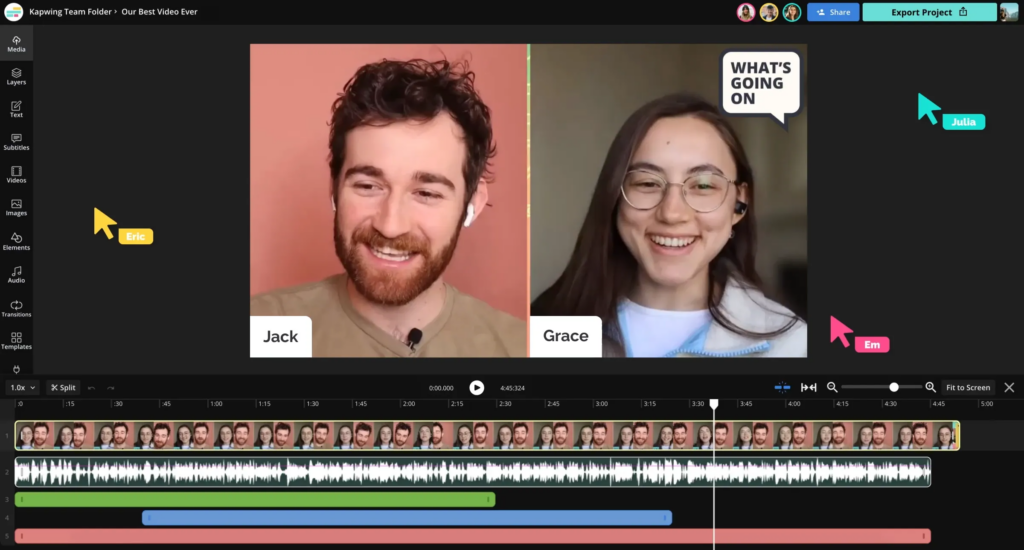
About the tool
Kapwing is an online editor for fast video trimming, resizing, captioning, and repurposing. It works well for quick edits of short-form and long-form content.
Pricing
Free plan available. Paid plans start around $16/month (annual billing).
Pros
- Quick video repurposing
- Auto-captioning tools
- Simple interface
Cons
- Limited motion graphics
- Slower performance on large files
5. VEED.io
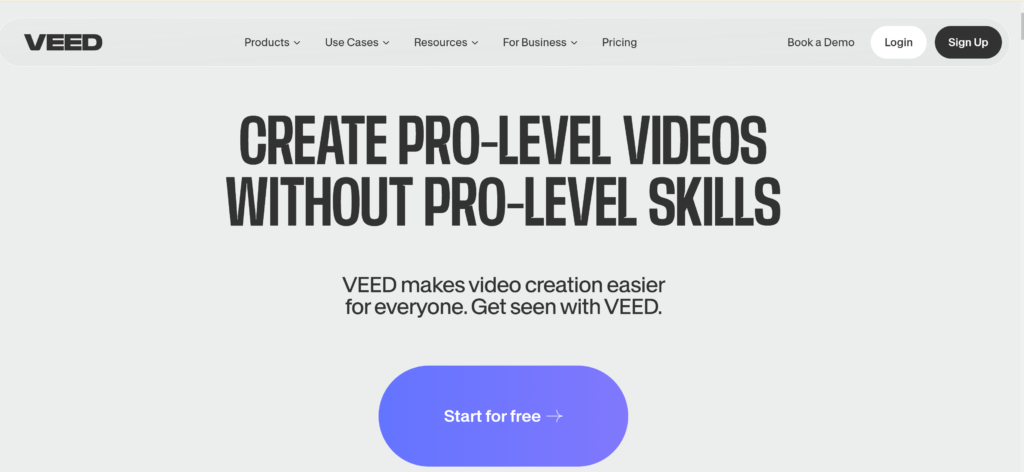
About the tool
VEED.io offers browser-based tools for producing formatted video ads with transitions, subtitles, and visual effects. Suitable for users who want cleaner videos without advanced editing software.
Pricing
Free plan available. Paid plans $18–$59/month.
Pros
- Clean video templates
- Easy editing interface
- Strong subtitle features
Cons
- Less control than full editors
- Some features require higher-tier plans
6. Piktochart
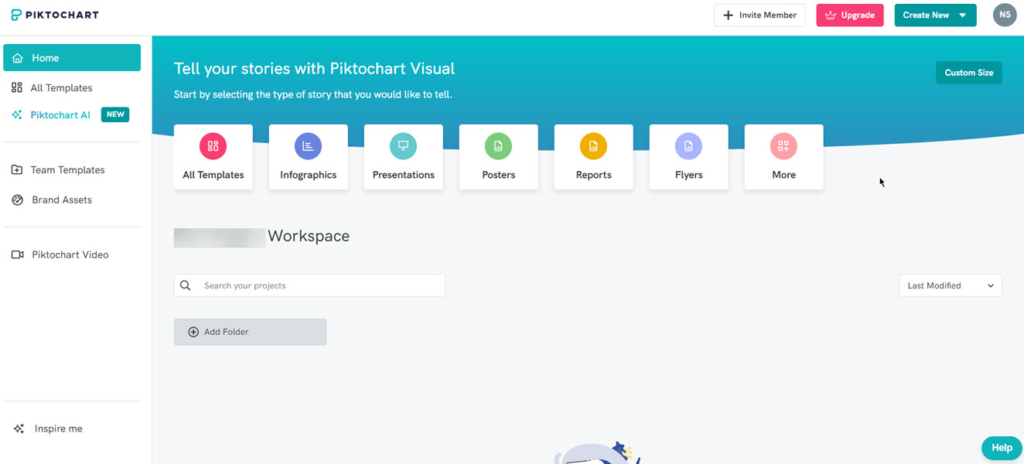
About the tool
Piktochart focuses on infographic-style visuals and data-based creative formats. It is frequently used in SaaS, finance, and B2B campaigns.
Pricing
Free plan available. Paid plans $14–$29/month.
Pros
- Strong infographic tools
- Good for data-driven creatives
- Modern templates
Cons
- Not ideal for product/lifestyle creatives
- Limited video options
7. VistaCreate
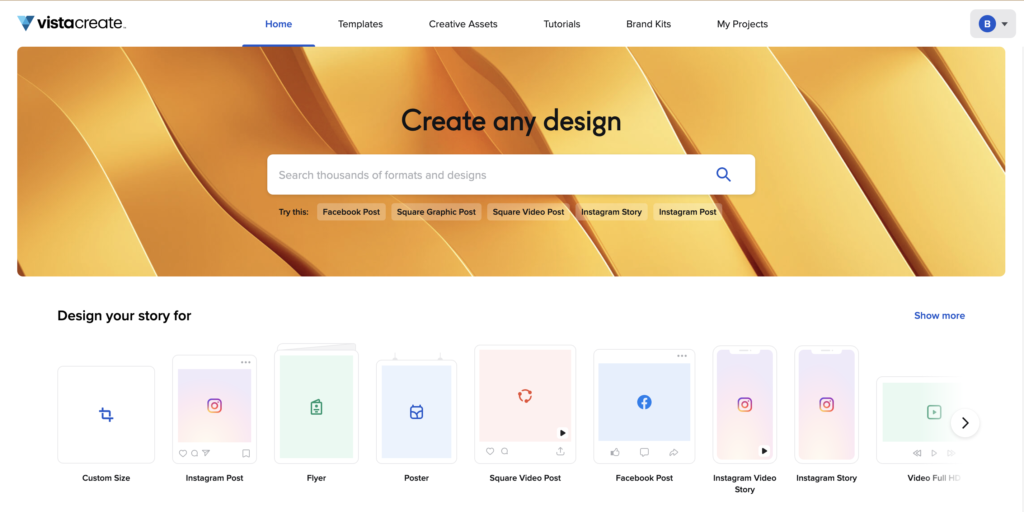
About the tool
VistaCreate provides templates for banners, social posts, and simple animated formats. It is commonly used for fast turnaround designs.
Pricing
Free plan available. Paid plan around $13/month.
Pros
- Useful banner templates
- Beginner-friendly
- Basic animations supported
Cons
- Limited AI capabilities
- Not suitable for large-scale creative workflows
8. Adobe Express
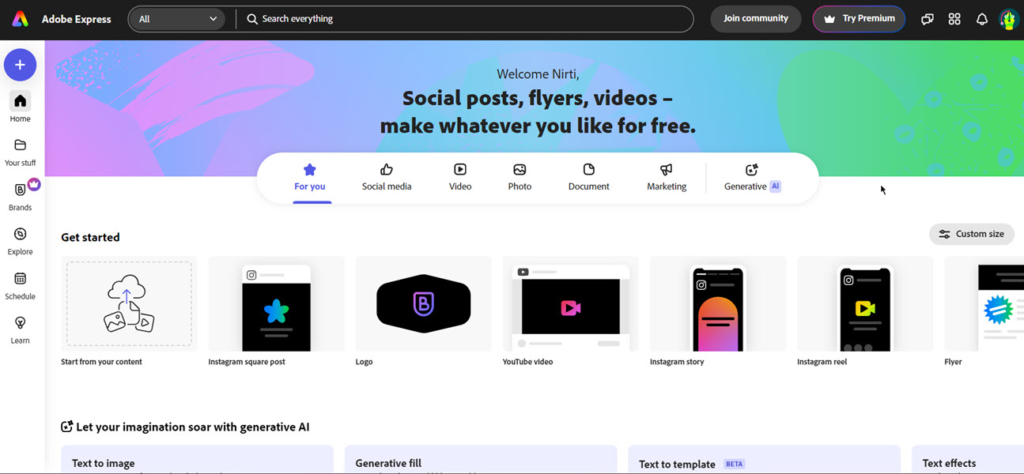
About the tool
Adobe Express includes high-quality design assets, Adobe fonts, and branded templates. It is typically used for producing polished static creatives.
Pricing
Free plan available. Paid plan starts at $9.99/month.
Pros
- Premium design assets
- Clean and professional UI
- Good template library
Cons
- Limited automation
- No bulk variation workflows
Best Practices for Maximizing Tool Use
To get consistent and measurable results from any ad-creative tool, focus on pairing automation with a structured workflow. Here are practical tips written in the exact format you requested.
- Set up brand templates first: Lock in fonts, colors, logos, and layout rules so every creative stays consistent across platforms.
- Generate multiple variations: Create several versions of each concept to quickly identify what resonates with your audience.
- A/B test consistently: Try a simple cadence such as testing three creatives for forty-eight hours, selecting the top performer, and scaling it.
- Automate resizing: Use your tool to quickly adapt creatives to Reels, Stories, YouTube Shorts, and display placements without manual edits.
- Run microtests before scaling: Test hooks, angles, and offers at a low budget to understand what works before increasing spend.
- Keep a human review step: Ensure every creative aligns with your brand voice and messaging before publishing.
- Use performance data to guide new creatives: Look at CTR, hook retention, and scroll-stop rate to steer the next round of designs.
- Build a reusable asset library: Keep winning headlines, colors, layouts, and formats ready for quick future production.
Pitfalls and What to Avoid
Even with great tools, certain mistakes can hold back performance. Avoid these common pitfalls to ensure your creatives stay effective and aligned with campaign goals.
- Relying only on default templates: This often leads to generic creatives that blend in instead of standing out. Always customize layouts, colors, and messaging.
- Ignoring platform specifications: Using the wrong aspect ratio or text layout can hurt delivery and engagement. Adapt creatives to each placement.
- Skipping localized variations: A single global creative rarely works everywhere. Adjust language, currency, visuals, and cultural cues for each market.
- Over-automating without review: AI speeds up creation, but human oversight ensures accuracy, brand tone, and compliance.
- Neglecting performance monitoring: Without tracking CTR, CPM, and creative fatigue, you can’t optimize effectively. Use data to refine your next variation.
- Using too few variations: Limiting yourself to one or two creatives reduces your chances of finding winners. Test multiple formats and angles regularly.
Conclusion
Creating high-performing ad creatives no longer has to be slow or complicated. With the right tools, you can speed up production, stay consistent across platforms, and run smarter test-and-scale campaigns. This is exactly why learning how to use the top tools to create digital ad creatives effectively can make a measurable difference in your results.
As you refine your workflow, focus on variation, automation, and data-driven improvement. And if you prefer an all-in-one solution that handles images, videos, UGC-style ads, captions, and resizing from a single brief, exploring a unified creative workflow platform is a great next step.
Canva and Predis.ai both offer free plans, but Predis.ai provides more AI-powered variations and video options.
Yes, platforms like Predis.ai can generate images, videos, and UGC-style ads from a single brief.
Start with three to five variations per concept, run short tests, and scale the top performer.
Yes, as long as you use brand guidelines and keep a quick human review step before publishing.
